| |
New Year's in Japan seems to be an ongoing celebration throughout the month of January. Shinnenkai, or New Year's gatherings held after January 1, bring people together to share in the optimism of the fresh year ahead and to partake in traditional events. We were invited to one such event last week, mochitsuki. As we've mentioned before, mochi is one of the traditional Japanese New Year's foods. Mochitsuki is the traditional mochi-making ceremony, during which members of the community use large wooden mallets to pound polished, cooked rice into a sticky paste. Once the paste is made, it is formed into small cakes, which can then be eaten. At the encouragement of our hosts, we took a turn kneading the mochi with the giant mallets. 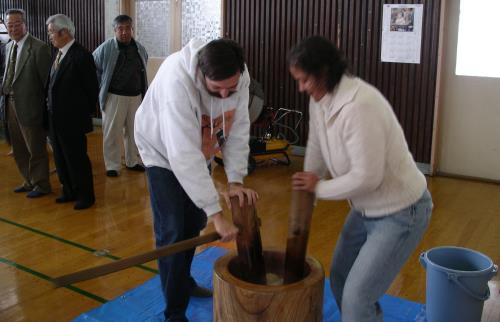 It was fun, but we clearly lacked the energy and expertise of the locals. 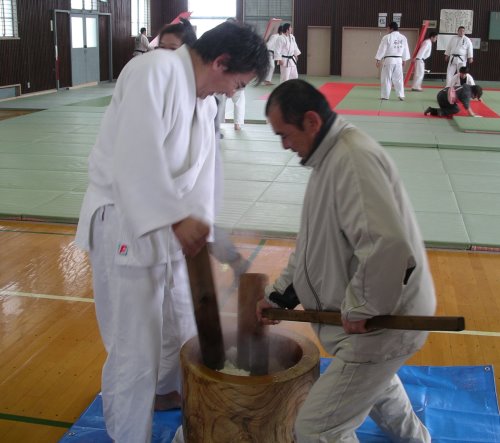 Once the kneading was completed, people alternated pounding the rice with a quick water rinse to keep it from sticking to the equipment. Children, assisted at times by their parents, got in on the pounding too. It was a great community event; one that we're glad we went out into the white-out conditions for.
Strawberry Fields for Winter
Last weekend, I had to make dessert for a dinner party. Wanting to do something with fruit, I headed to the produce section, thinking about citrus or maybe pears. Those thoughts were blown out of my head by the sight of row upon row of . . . bright red strawberries. And a big sign proclaiming the arrival of the "Strawberry Fair." In Japan, winter is the high season of the strawberry. Strawberries sit in little boxes in displays at the front of the store, announcing their provenance and price ("Fresh Strawberries from Sendai! 680 yen!"), drawing attention away from all the other fruits. Every patisserie sets out an array of strawberried treats ― filled, topped, stuffed with jam, you name it. Strawberry KitKats, strawberry danish, and strawberry eclairs are everywhere. Traditional sweets, like daifuku ( anko-filled mochi balls) contain strawberries at this time of year, too. The prominence of strawberries in January is very strange to me because, as for most Americans, strawberries scream "summer!" It seems somehow wrong to see them everywhere when we're still rocking our snowboots every day. A bit of research revealed that in many parts of Japan, strawberries alternate with rice as a part-of-the-year crop, so it's not completely out of the question that they would be reaching peak over the winter months. In fact, the strawberries we've eaten were grown in Japan and were quite delicious. On the other hand, it makes me think: perhaps the strawberry producers are in cahoots with the weathermen ("If we sell strawberries during the winter, they'll make people think of summer! They'll forget that the temperature hasn't gotten above freezing in six days, and all will be right as rain!).
J-Life Lesson #46: When living in a part of the country where it snows every day during the winter, check frequently on your air-drying laundry. 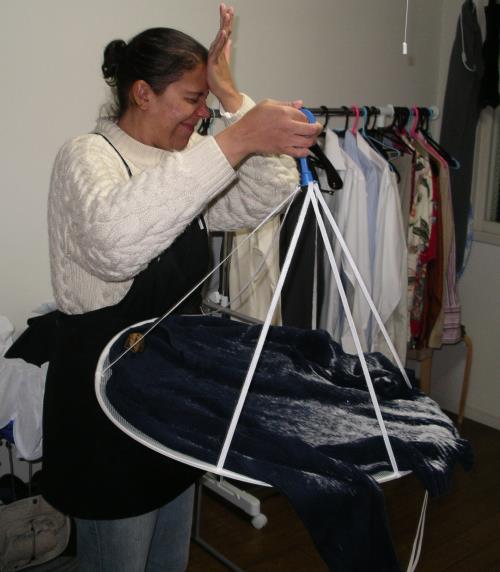
Let's take a look at today's weather, shall we? Here's the weather report. It's pretty typical for winter in Tohoku: snow in the morning, and cloudy all day after that. 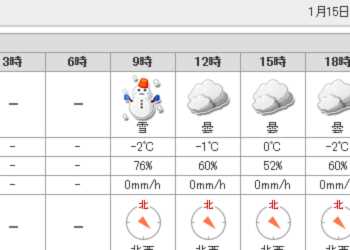 Now, let's take a look out the window: 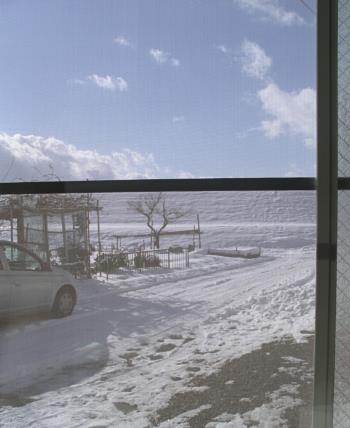 That's about how it goes with the weather forecasts here. They aren't just inaccurate, they're willfully dishonest, or at least it seems so. My theory is that the weathermen are part of a secret government program to emotionally control the people and prevent revolt. When it's nice out (or will be), the forecast shows nasty weather, so that everyone gets a pleasant surprise and is happy. When it's nasty out, the forecast shows nice weather tomorrow or the next day, which gives people hope (even though the nice weather doesn't actually arrive until three weeks later).
Tuesday, January 15, 2008, 1:29 AM General, FoodPosted by matthew At dinner with friends the other night, the topic of horseradish came up. This left our Japanese friends at a loss, as they'd never heard of the stuff. We tried to explain, "it's like wasabi, but it's white. In fact, we call wasabi, 'Japanese horseradish' in English."
A quick dictionary consult, and we had found the Japanese name for horseradish: seiyou wasabi (西洋わさび) — literally, "Western wasabi".
[ 3 comments ] permalink
Best Use of All Your Dishes
As longtime readers of the blog know, learning to cook Japanese food has been one of the great pleasures of my life here (eating the Japanese food has been Matthew's great pleasure). Last week, I got really ambitious and decided to make a standard ichiju-sansai dinner. Ichiju-sansai consists of soup and three small dishes, as well as steamed rice and tsukemono (pickles). These dishes come from families of foods named by their method of preparation, such as suimono (vinegared dishes), nimono (simmered dishes), and mushimono (steamed dishes). Each dish should come from a different family. For our dinner, we had a nimono ( kinpira gobou, simmered burdock root), an aemono ( shira-ae, tofu dressing on vegetables and konnyaku), and sashimi ( katsuo tataki, seared bonito) with ponzu sauce. The tsukemono were pickled carrots from my nuka-zuke bed. 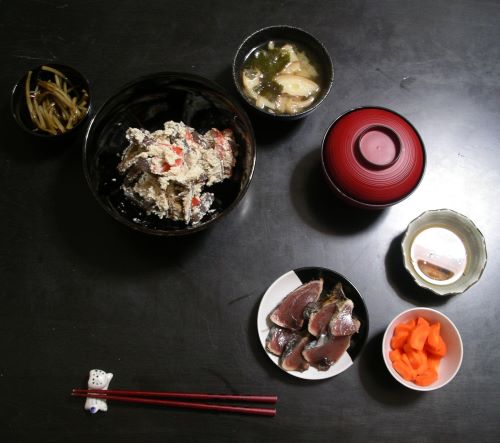 Making the dinner was pretty time-consuming, as was the cleanup. It was totally worth the effort.
Fugu, the pufferfish perhaps best known for its potential lethality as a foodstuff, is in season now. This restaurant is advertising its Fugu Festival. 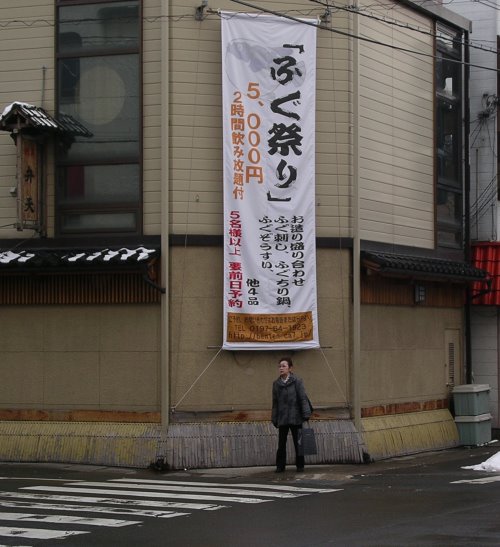 The festival appears to be featuring a sampler of fugu dishes, including fugu sashimi, fugu chirinabe (hotpot), and fugu zousui (rice porridge mixed with soup). There are four other unnamed dishes available as well. It's 5,000 yen for two hours of nomihoudai (all-you-can-drink) and the fugu sampler ― we're passing on this one.
[ 3 comments ] permalink
Many people in Japan, male and female alike, hang multiple small mascots from their keitai (cell phones). Mascots range from characters associated with the phone company to well-known comic, manga, or anime characters. I've only got one on my cute pink phone. 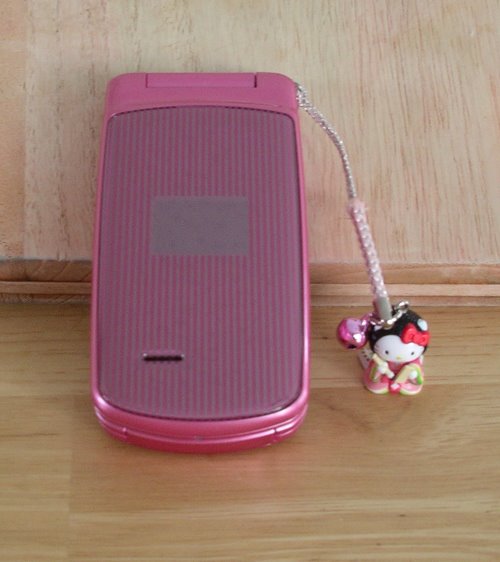 It's Hello Kitty, of course, but she's special. Sanrio makes Hello Kitty merchandise specific to each of the prefectures, representing events or products for which the prefecture is known. This Kitty-chan represents the famous Heian period poetess, Komachi, who according to legend was from what is now Akita Prefecture. Komachi was also regarded as a great beauty, which Matthew thinks makes her name particularly fitting for the Akita Shinkansen. 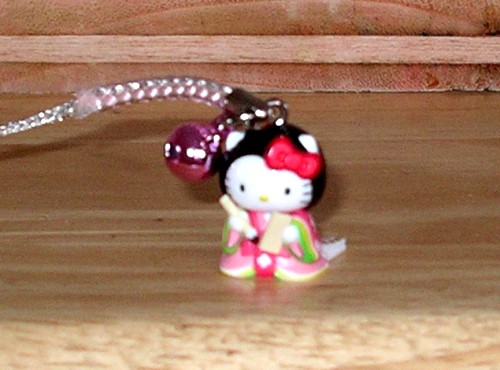
Tuesday, January 8, 2008, 8:27 PM GeneralPosted by stefanie About a month ago, during one of the early snows in Kitakami, I was chatting with a woman who had lived here for many years. We agreed that the weather was quite bleak, then she put on her ganbarimasu! face and said: "Now is the time when Kitakami becomes a frozen city." The mountain gods must have disagreed with that assessment, for that particular snow didn't last very long.
January, it seems, is the time when Kitakami becomes a frozen city. Since New Year's Day, we've had a couple more brief snows that covered the residual snow from that storm. Thin layers of ice cover the snow in the mornings, and bands of ice have spanned the Waga River at times. The snow remains a few inches deep in many spots, which seems to irritate Moki on walks ― he dislikes having to slog through the snow. The roads are mostly cleared, but there are still patches that turn to slush during the day and back to thick sheets of ice at night.
Even more telling was the bit of ice that fell off my Docs in the car during my store run this afternoon. I hopped back into the car after my stop at the grocery, and this ice clump, which apparently fell off en route, hadn't melted AT ALL. Given that, I felt pretty comfortable leaving the fish necks I'd just bought in the car during my kerosene and dog food stop.
According to the weathermen (who are an entirely different blog post), the low in Kitakami this evening is supposed to reach -8 Celsius tonight. Now is the time when we put on our ganbarimasu! faces, throw on another layer of clothes, and discover life in the frozen city.
[ 3 comments ] permalink
Monday, January 7, 2008, 12:38 PM GeneralPosted by matthew We had snow on New Year's Eve and New Year's Day, with enough accumulation that the embankment near our house became attractive to youngsters wanting to sled or build snowmen. And to us, too. On the 2nd, we gave in to temptation and went to play in the snow. Atop the hill there were already two squat Japanese-style (two-ball) snowmen. There was still plenty of snow, so we decided we'd build a western-style snowman with three balls. And not only that, we'd make it huge! To make a big snowman, you need some big snowballs. Of course you have to start small. 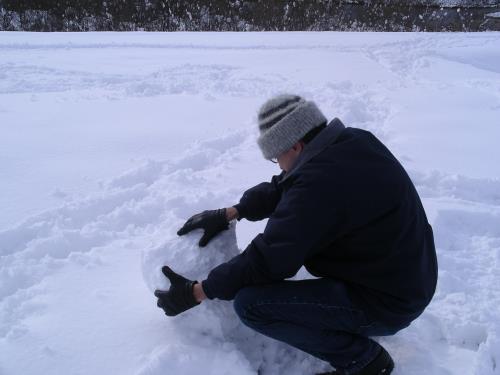 As you roll it around, it gets bigger. You can grow your snowball faster if you don't restrict yourself to rolling up only snow. 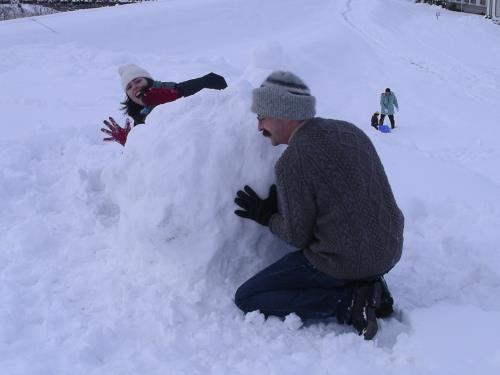 Eventually the snowball got big enough that it took two of us to roll it, then all three of us. We maneuvered it into place to be our snowman base. The torso and head snowballs went much faster, and before long we had a friendly snowman with gravel eyes and wearing Matthew's hat. 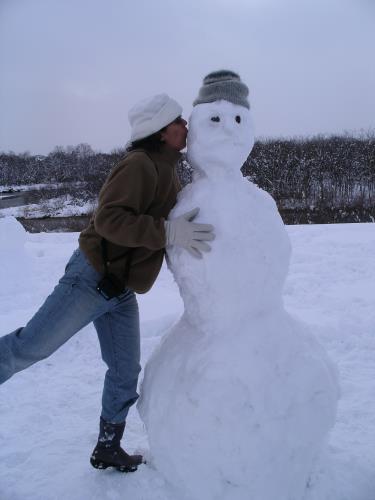 Then Matthew took his hat back. On our way home, we noticed the snowman seemed rather ominous. He towered at the top of the hill, looming over the neighborhood, menacing all with his beady eyes. 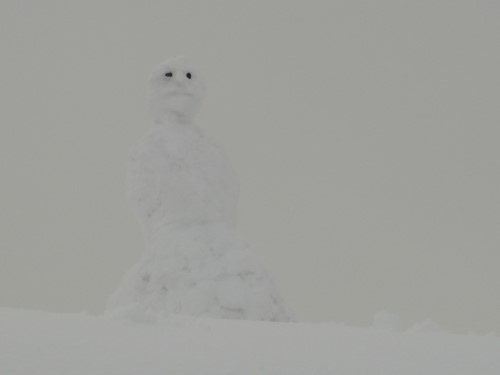 That photo doesn't really capture the feel of it, though. There just wasn't enough contrast between the snowman, ground, and sky. Thanks to the miracle of computers, though, we were able enhance the image so you can see what we mean. 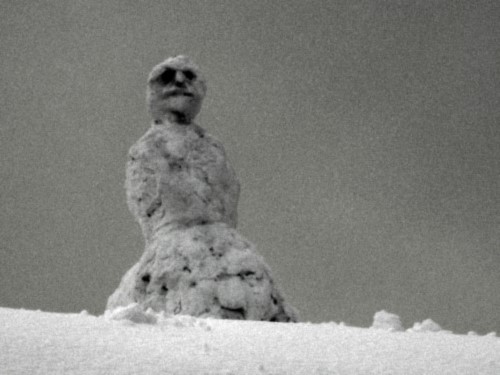 His reign was not to be a long one, though. The next day, some kids took him apart with a shovel and tried to roll the base snowball some more, but found it to be too heavy. For a different account of this adventure, be sure to read Please Take Recess.
[ 4 comments ] permalink
Back Next
|
|
















 Calendar
Calendar




